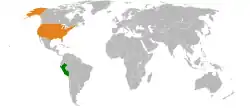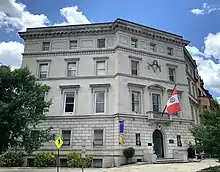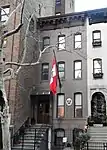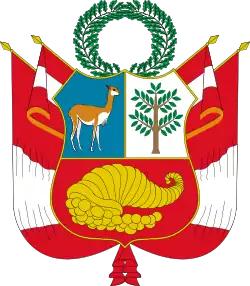Peru–United States relations
Peru and the United States established relations on May 2, 1826, following Peru's independence from Spain.
 | |
Peru |
United States |
|---|---|
| Diplomatic mission | |
| Embassy of Peru, Washington, D.C. | Embassy of the United States, Lima |
| Envoy | |
| Peruvian Ambassador to the United States Hugo de Zela | American Ambassador to Peru Lisa S. Dougherty Kenna |
According to Gallup, Inc. polls, Peruvian public perception of the United States is mixed, with 51% of Peruvians viewing the U.S. favorably in 2017 (compared to 61% approval of China, respectively)[1] and 55% of Peruvians viewing American influence positively in 2013.[2] According to a Gallup poll discussing confidence in the president of the United States, 17% of Peruvians approved of U.S. leadership, with 77% disapproving.[1]
History
.jpg.webp)
Twentieth century
Through the Cold War, the United States focused its foreign policy of promoting anti-communism in Peru instead of assisting with democratic efforts.[3] During the administration of Ronald Reagan, Peru was ignored by his government.[3] When President Fernando Belaunde Terry visited President Reagan in Washington in 1983, Reagan gave the Peruvian president only thirty minutes of time, with one of Reagan's aides saying "[President Belaunde] wasn't even offered a cup of tea".[3]
Relations reached their lowest point during the United States invasion of Panama of 1989 when Peru recalled its ambassador in protest of American military actions.[4][5] However, relations were restored and have recovered and vastly expanded in the decades since.
The United States heavily supported the presidency of Alberto Fujimori under Plan Verde, of which Fujimori mainly served as a figurehead for Vladimiro Montesinos, a Peruvian intelligence official with deep links to the Central Intelligence Agency. The United States also supported Fujimori through his seizure of power and an internal insurgency.[6][7][8][9][10]
Twenty-first century
Peru enjoys strong and cooperative relations with the United States. Relations were strained following the tainted reelection of former President Alberto Fujimori in June 2000.
Relations improved with the installation of an interim government in November 2000 and the inauguration of the government of Alejandro Toledo in July 2001. Under Alan García's administration were positive. The United States continues to promote the strengthening of democratic institutions and human rights safeguards in Peru and the integration of Peru into the world economy.
The Cuzco Consulate assisted a group of American backpackers who were attacked by Peruvian villagers who suspected the group were "cattle rustlers".[11]
In 2002, nine people died when a car bomb detonated by suspected rebels in the Peruvian capital just days before a visit from American President George W. Bush.
During its time as a non-permanent member of the UN Security Council from 2006 to 2007,[12] Peru (despite having refrained from openly participating in George Bush's "War on Terrorism" itself), alongside the U.S. and the West, repeatedly voted in favor of extending the authorization mandate of the International Security Assistance Force in Afghanistan,[13][14] and increasing sanctions against Iran over its controversial nuclear program.[15][16]
The U.S. and Peruvian governments criticized North Korea's 2006 nuclear test; according to an official notice issued by the Peruvian Ministry of Foreign Affairs, "This is a serious event, that violates the effective moratorium for nuclear tests, constitutes a threat to international peace and security and aggravates the tensions in the Korean Peninsula and in the Northeastern Pacific." The note also remarked that, "as a state member of the Security Council, the Government of Peru considers that, in accordance with the Chart of the United Nations, this situation must be examined through the existing multilateral mechanisms". Peru urged North Korea to unconditionally return to the Six-Party Talks and to suspend all activity related to its nuclear program and also reiterated its "firm commitment with non-proliferation efforts, and the suitable mechanisms for the promotion of the strategic stability, international peace and security".
In 2007, Peruvian Foreign Minister José Antonio García Belaúnde said that his country opposed America's occupation of Iraq, and called for the immediate withdrawal of US military forces from the country: "We are against the invasion of Iraq, and hope the military forces will leave that country soon to bring sovereignty back," noting the Iraqi situation was very complex and the invasion was a mistake on Washington's part.
In 2008, Peru joined the U.S. and its allies in recognizing Kosovo,[17] and ultimately refused to recognize South Ossetia and Abkhazia,[18] yet opposed the U.S. and Israel by recognizing Palestine in 2011, claiming "no pressure from any side".[19] In reaction to the Libyan Civil War, Peru became the first country to cut ties with Libya "until the violence against the people ceases" as a result of the aerial bombing of Tripoli. Peru's President Alan García stated, "Peru strongly protests against the repression unleashed by the dictatorship of Muammar al-Gaddafi against the people who are demanding democratic reforms to change the government which has been led for 40 years by the same person." Garcia said that Peru would ask the UN Security Council to establish a no-fly zone over Libya to prevent the use of the country's warplanes against the population.[20]
Upon the death of Osama bin Laden in 2011, Garcia credited the death of bin Laden to late and recently beatified Pope John Paul II, saying, "His first miracle was to remove from the world the incarnation of evil, the demonic incarnation of crime and hatred..." He also said that bin Laden's death "vindicates [former U.S. President] George W. Bush's decision to punish Bin Laden and patiently continue this work that has borne fruit".[21]
While Peru's Deputy Foreign Minister José Beraún Araníbar condemned "the excesses committed by the government of Syria" in a 2012 interview,[22] Peru later joined Ecuador and Russia in taking a common stance on the Syrian civil war, with Araníbar stating, "The principle of non-interference has been adopted and advocated by the United Nations and Peru means to keep to it in the Syrian case," also stressing that Peru saw a political dialogue as the only viable means of peace enforcement and supported a joint UN/Arab League initiative to this effect, indicating Peru would not likely support a U.S. intervention.[23]
In June 2013, Peruvian President Ollanta Humala visited the White House and together with U.S. President Barack Obama promised to strengthen ties between both nations, including in the fight against narcotics trafficking and in tightening economic ties.[24]
The US government condemned Pedro Castillo's attempted self-coup in December 2022 and welcomed the appointment of Dina Boluarte as president.[25][26] Castillo eventually alleged that the United States aided his removal.[27][28][29][30] The US also initially supported Boluarte amidst civil unrest against her government and allegations of authoritarianism.[31] Relations have deteriorated under the government of her after the U.S condemned Peru for human rights violations.[32] 15 Democratic members of Congress also condemned the Peruvian government, expressing concern over the 'authoritarian' practices Congress of the Republic.[33] Relations were further complicated after President Joe Biden was widely criticized for describing Boluarte's government as democratic, while democratic backsliding has reportedly hit an all time high in Peru.[34][35][36]
Resident diplomatic missions
The U.S. maintains an embassy in Lima. There is a U.S. Consular Agency in Cuzco, and the USAID building is located in Lima. The current U.S. ambassador is Lisa D. Kenna.


 Peruvian consulate-general in New York
Peruvian consulate-general in New York
Trade and economy
U.S. investment and tourism in Peru have grown substantially in recent years. The U.S. is Peru's number one trade partner, and economic and commercial ties will deepen if the U.S.–Peru Trade Promotion Agreement (PTPA) is passed by the U.S. Congress. About 200,000 U.S. citizens visit Peru annually for business, tourism, and study. About 16,000 Americans reside in Peru, and more than 400 U.S. companies are represented in the country.
Strategic partnerships

_and_the_Peruvian_navy_landing_platform_dock_ship_BAP_Pisco_(AMP-156)_conduct_tactical_maneuvers_in_the_eastern_Pacific_Ocean_during_UNITAS_LXII._(51535611938).jpg.webp)
Illicit substances
The United States and Peru cooperate on efforts to interdict the flow of narcotics, particularly cocaine, to the United States. Bilateral programs are now in effect to reduce the flow of drugs through Peru's port systems and to perform ground interdiction in tandem with successful law enforcement operations. These U.S. Government-supported law enforcement efforts are complemented by an aggressive effort to establish an alternative development program for coca farmers in key coca growing areas to voluntarily reduce and eliminate coca cultivation. This effort is funded by the Department of State's Bureau for International Narcotics and Law Enforcement Affairs (INL) and the U.S. Agency for International Development (USAID).
Military
Peru remains part of SICOFAA (whose creation was proposed by the Peruvian Air Force in 1964) and the Rio Pact, requiring it and the U.S. to assist each other in case of attack, and continues to be a regular participant in RIMPAC, an international maritime military exercise led by the U.S. to promote stability throughout the Pacific in the event of potential conflicts ranging from China invading Taiwan or North Korean aggression against its neighbors.
See also
References
![]() This article incorporates public domain material from U.S. Bilateral Relations Fact Sheets. United States Department of State.
This article incorporates public domain material from U.S. Bilateral Relations Fact Sheets. United States Department of State.
- Pew Global Indicators Databse: Peru.
- 2013 World Service Poll BBC
- Riding, Alan (1984-12-30). "Debt Is Undermining Democracy in Peru". The New York Times. ISSN 0362-4331. Retrieved 2020-07-19.
- McClintock, Cynthia; Vallas, Fabián (2005). La democracia negociada: las relaciones Perú-Estados Unidos (1980-2000). Instituto de Estudios peruanos. p. 117. ISBN 9972511251.
- "Perú retira a su embajador en Washington". Boletín de Prensa Latinoamericana. 1989-12-21.
- "Spymaster". Australian Broadcasting Corporation. August 2002. Retrieved 29 March 2023.
Lester: Though few questioned it , Montesinos was a novel choice. Peru's army had banished him for selling secrets to America's CIA, but he'd prospered as a defence lawyer – for accused drug traffickers. ... Lester: Did Fujmori control Montesinos or did Montesinos control Fujimori? ... Shifter: As information comes out, it seems increasingly clear that Montesinos was the power in Peru.
- McMillan, John; Zoido, Pablo (Autumn 2004). "How to Subvert Democracy: Montesinos in Peru". The Journal of Economic Perspectives. 18 (4): 69-92. doi:10.1257/0895330042632690. S2CID 219372153.
- "CIA Gave $10 Million to Peru's Ex-Spymaster Montesinos, Center for Public Integrity, 18 July 2001. Accessed online 15 October 2019
- Hall, Kevin G. (3 August 2001). "CIA Paid Millions to Montesinos". The Miami Herald. Miami. p. 1.
- Alfredo Schulte-Bockholt (2006). "Chapter 5: Elites, Cocaine, and Power in Colombia and Peru". The politics of organized crime and the organized crime of politics: a study in criminal power. Lexington Books. pp. 114–118. ISBN 978-0-7391-1358-5.
important members of the officer corps, particularly within the army, had been contemplating a military coup and the establishment of an authoritarian regime, or a so-called directed democracy. The project was known as 'Plan Verde', the Green Plan. ... Fujimori essentially adopted the Green Plan and the military became a partner in the regime. ... The self-coup, of April 5, 1992, dissolved the Congress and the country's constitution and allowed for the implementation of the most important components of the Green Plan
- John Hall (4 February 2013). "Bound, beaten and robbed: Backpackers attacked by whip-brandishing Peruvian villagers in 'savage' two day ordeal". The Independent. Archived from the original on 2022-05-25. Retrieved 6 February 2013.
- Countries Elected Members of the Security Council
- United Nations Security Council Resolution 1707
- United Nations Security Council Resolution 1776
- United Nations Security Council Resolution 1737
- United Nations Security Council Resolution 1747
- Peru formally recognizes Kosovo as independent state Andina
- International recognition of Abkhazia and South Ossetia
- Peru recognizes Palestinian state guardian.co.uk
- "Peru suspends diplomatic relations with Libya". www.peruviantimes.com. Retrieved 2011-02-23.
- "Peru leader credits late pope for bin Laden death". Forbes.com. May 2, 2011. Archived from the original on May 4, 2011. Retrieved May 2, 2011.
- Peru minister condemns excesses of Syrian regime Arab News
- Russian, Peru and Ecuador join voices on Syria Voice of Russia
- U.S., Peru Presidents Pledge to Fight Trafficking June 11, 2013 WSJ
- https://www.reuters.com/world/americas/us-says-welcomes-appointment-boluarte-perus-president-2022-12-08/
- "Castillo moves to dissolve Peruvian Congress, it impeaches him". Al Jazeera. Retrieved 2022-12-07.
- "They denounce US interference in the dismissal of Pedro Castillo". Ultimas Noticias. 19 December 2022.
- "La Jornada: Se reúnen embajadora de EU y ministro de Defensa antes del golpe". La Jornada (in Mexican Spanish). 16 December 2022. Retrieved 3 January 2023.
- "Pedro Castillo denuncia en una carta "plan maquiavélico" en su contra". Últimas Noticias (in Spanish). 11 December 2022. Retrieved 2022-12-14.
- https://english.almayadeen.net/news/politics/the-us-has-been-planning-castillos-downfall-all-along:-euras
- https://www.wsws.org/en/articles/2023/07/22/ywda-j22.html
- "EE. UU. señala un "problema" de impunidad ante abusos policiales en Perú". La República (in Spanish). 20 March 2023. Retrieved 2023-03-28.
- Vega, Renzo Gómez (2023-07-29). "US Democrats pressure President Dina Boluarte over Peru's human rights violations". El País. Retrieved 2023-07-30.
- Vasquez, Laura (2023-08-01). "Boluarte recibe respaldo de Biden pese a que congresistas denunciaron vulneración de derechos en protestas". La República (in Spanish). Retrieved 2023-08-02.
- Paucar, Luis (2 August 2023). "Joe Biden ratifica respaldo a Dina Boluarte: "Espero con interés continuar nuestra colaboración"". infobae (in European Spanish). Retrieved 2023-08-02.
- https://apnews.com/article/politics-united-states-government-district-of-columbia-caribbean-dina-boluarte-518fac934a1ad6209d90434030889e55
Further reading
| Library resources about Peru–United States relations |
- Brands, Hal. "The United States and the Peruvian Challenge, 1968–1975." Diplomacy & Statecraft 21.3 (2010): 471–490. online
- Carey,James. Peru and the United States, 1900-1962 (U of Notre Dame Press, 1964).
- Clayton, Lawrence. Peru and the United States: The Condor and the Eagle" ( U of Georgia Press, 1999).
- De Ferrari, Gabriella. Gringa Latina: A Woman of Two Worlds (Houghton Mifflin, 1996).
- Jasper, M. L. and C. R. Seelke. "Peru: Political Situation, Economic Conditions and U. S. Relations" (US Congressional Research Service, January 15, 2008) online
- Kofas, Jon V. Foreign Debt and Underdevelopment: U.S.-Peruvian Economic Relations (University Press of America, 1996).
- McClintock, Cynthia, and Fabián Valias. The United States and Peru: Cooperation at a Cost (Routledge, 2018).
- McClintock, Cynthia, and Fabian Vallas. "The United States and Peru in the 2000s." in Contemporary US-Latin American Relations (Routledge, 2010) pp. 217-237.
- Olson, Richard Stuart. “Economic Coercion in International Disputes: The United States and Peru in the IPC Expropriation Dispute of 1968-1971.” Journal of Developing Areas 9#3 (1975): 395–414.
- Packel, John. "Peruvian Americans." Gale Encyclopedia of Multicultural America, edited by Thomas Riggs, (3rd ed., vol. 3, Gale, 2014), pp. 467–476. online
- Paerregaard, Karsten. “Inside the Hispanic Melting Pot: Negotiating National and Multicultural Identities among Peruvians in the United States.” Latino Studies 3 (2005): 76–96.
- Pike, Frederick. The United States and the Andean Republics: Peru, Bolivia, and Ecuador (Harvard UP, 1977).
- Roberts, Lauren. "Comparing Theoretical Explanations Regarding United States Decision-Making on Regime Change in Peru and in Chile from 1968 to 1973." (2021).online
- Sharp, Daniel. U.S. Foreign Policy and Peru (U of Texas Press, 1972).
- Stephenson, Hollie E. "The Pinnacle of United States-Peru Relations: A Survey of the Motivations for and the Ratification Process of the United States-Peru Trade Promotion Agreement." (PhD Diss. Johns Hopkins University, 2008) online, with long bibliography
- Taft–Morales, Maureen. Peru: Current Conditions and U.S. Relations (US Congressional Research Service, July 21, 2009) online
- Walter, Richard. Peru and the United States, 1960-1975: How their Ambassadors Managed Foreign Relations in a Turbulent Era (Pennsylvania State UP, 2010)
- Wordliczek, Rafał. "USAID, Foreign Military Financing, and Total Assistance USAID." Americana 11#2 (2015) online
